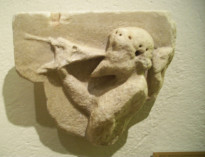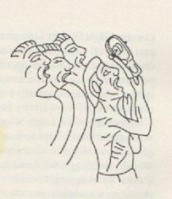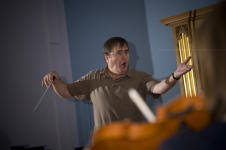A Family of Song: Reflections of Albanian Urban Lyric Song in the Mediterranean, 2005
This essay discusses the origins and development of a unique branch of music, the Albanian urban lyric song, which began to appear in the early years of the nineteenth century, had its Golden Age in the 1930s, and is still a part of Albanian musical culture today. The songs which grew up and flourished in the different regions were passed down orally through the generations and this tradition, to some extent, persists today. The Albanian urban lyric songs represented a great step forward in music making, because they were the first Albanian songs to be written down and so could reach wider audiences than the existing repertoires, which until then had been performed by regional singers for regional audiences.
A Family of Song.doc
Microsoft Word document [103.5 KB]
This essay discusses the origins and development of a unique branch of music, the Albanian urban lyric song, which began to appear in the early years of the nineteenth century, had its Golden Age in the 1930s, and is still a part of Albanian musical culture today. The songs which grew up and flourished in the different regions were passed down orally through the generations and this tradition, to some extent, persists today. The Albanian urban lyric songs represented a great step forward in music making, because they were the first Albanian songs to be written down and so could reach wider audiences than the existing repertoires, which until then had been performed by regional singers for regional audiences.
A Family of Song.doc
Microsoft Word document [103.5 KB]
Shostakovich, Kadaré and the nature of dissidence: an Albanian view
This article concerns the effect of the communist totalitarian system on two great artists: Dmitri Shostakovich, who lived under Soviet rule before and after the Second World War, and the Albanian author Ismail Kadaré, whose career developed over the last 40 years of the 20th century. In this context readers may need to be reminded of the remarkable isolation of Albania during the post-war communist regime; and it is also worth recalling that most composers throughout the ages have encountered some form of artistic constraint – consider, for example, Bach, Haydn and Beethoven, each of whom had to compose some of their works to order, however benevolent their patrons. The constraints imposed by communist regimes were an extreme example of this master-servant relationship, although one mu
Shostakovich Kadare.pdf
Adobe Acrobat document [95.7 KB]
This article concerns the effect of the communist totalitarian system on two great artists: Dmitri Shostakovich, who lived under Soviet rule before and after the Second World War, and the Albanian author Ismail Kadaré, whose career developed over the last 40 years of the 20th century. In this context readers may need to be reminded of the remarkable isolation of Albania during the post-war communist regime; and it is also worth recalling that most composers throughout the ages have encountered some form of artistic constraint – consider, for example, Bach, Haydn and Beethoven, each of whom had to compose some of their works to order, however benevolent their patrons. The constraints imposed by communist regimes were an extreme example of this master-servant relationship, although one mu
Shostakovich Kadare.pdf
Adobe Acrobat document [95.7 KB]
The Iso(n)—a Participatory Component in the South Albanian Multipart Unaccompanied Singing and in Byzantine Chant, 2015
The Iso(n)—a Participatory Component in [...]
Microsoft Word document [64.0 KB]
The Iso(n)—a Participatory Component in [...]
Microsoft Word document [64.0 KB]
Samuel Baud-Bovy, an Independent Voice between Local Schools of Thought and Globally Dominant Trends
Baud-Bovy was an excellent observer of the multipart singing, poetic rhythm and the existence of a common repertory among the Greeks and the Albanians. Songs of the north of Epirus, points out Baud-Bovy, are an exceptional phenomenon in the Greek repertoire in that they feature a strange polyphony comprising the two soloist voices and the third, a drone. This ‘is a characteristic of the men’s songs of the Cham people recorded by Mr. and Mrs. Stockmann. We can be certain that the above actually originated from Albania and were adopted by the Greeks, given that both peoples had lived for long periods in close cultural symbiosis’ (Baud-Bovy 1972, 158). The pentatonic system or the pentatonic modes, applied in both multipart singing and monodic singing of the Southwest Balkans, are those
01-'Baud-Bovy', Tbilisi paper 2016.doc
Microsoft Word document [644.5 KB]
Baud-Bovy was an excellent observer of the multipart singing, poetic rhythm and the existence of a common repertory among the Greeks and the Albanians. Songs of the north of Epirus, points out Baud-Bovy, are an exceptional phenomenon in the Greek repertoire in that they feature a strange polyphony comprising the two soloist voices and the third, a drone. This ‘is a characteristic of the men’s songs of the Cham people recorded by Mr. and Mrs. Stockmann. We can be certain that the above actually originated from Albania and were adopted by the Greeks, given that both peoples had lived for long periods in close cultural symbiosis’ (Baud-Bovy 1972, 158). The pentatonic system or the pentatonic modes, applied in both multipart singing and monodic singing of the Southwest Balkans, are those
01-'Baud-Bovy', Tbilisi paper 2016.doc
Microsoft Word document [644.5 KB]
Bloomsbury Encyclopedia of Popular Music of the World, Volume 11, 2017
Bloomsbury Encyclopedia of Popular Music[...]
Microsoft Word document [30.9 KB]
Bloomsbury Encyclopedia of Popular Music[...]
Microsoft Word document [30.9 KB]
Korçare Distinctive Song (Kënga Karakteristike Korçare)
In the second half of the 19th century and mostly around the beginning of the 20th, apart from the Korçë traditional songs mostly of a pentatonic melodic organisation, as well as rural and stylised urban songs, a distinctive type of song was developed in Albania; Kënga Karakteristike Korçare (KKK), the songs of the Korçë area.
Kënga Karakteristike Korçare.docx
Microsoft Word document [19.4 MB]
In the second half of the 19th century and mostly around the beginning of the 20th, apart from the Korçë traditional songs mostly of a pentatonic melodic organisation, as well as rural and stylised urban songs, a distinctive type of song was developed in Albania; Kënga Karakteristike Korçare (KKK), the songs of the Korçë area.
Kënga Karakteristike Korçare.docx
Microsoft Word document [19.4 MB]
The Saze Instrumental Ensembles of South East Albania
The Saze semi-professional ensembles are spread throughout the South and South East of Albania, particularly in the Korçë area, and extend to Epirus, northern Greece. Some of the most renowned Saze groups were made up of family members since musical talent seemed to be a genetic requisite in these families. Thanks to their ability for ‘freeing’ music from local, ethnic or national ideas, the wandering Saze musicians adapted parts of the national heritage to their taste and styles and stored them in their own idiomatic repertoire. The ‘wandering’ way of life which the Saze-s represented, facilitated them in enriching their repertoire with characteristics of the various ethnic groups.
The Saze Instrumental Ensembles of South[...]
Microsoft Word document [24.8 KB]
The Saze semi-professional ensembles are spread throughout the South and South East of Albania, particularly in the Korçë area, and extend to Epirus, northern Greece. Some of the most renowned Saze groups were made up of family members since musical talent seemed to be a genetic requisite in these families. Thanks to their ability for ‘freeing’ music from local, ethnic or national ideas, the wandering Saze musicians adapted parts of the national heritage to their taste and styles and stored them in their own idiomatic repertoire. The ‘wandering’ way of life which the Saze-s represented, facilitated them in enriching their repertoire with characteristics of the various ethnic groups.
The Saze Instrumental Ensembles of South[...]
Microsoft Word document [24.8 KB]
Kosta P. Manojlović on Albanian Music
Kosta Manojlović was a Serbian composer, musicologist, choral conductor, folklorist and educator, who in the mid-1930s harmonised and arranged for mixed choirs and solo voices several Albanian choral songs. He published them in 1933 as a collection of choral songs based on traditional and urban songs from Albania and titled it 'The Songs from the Land of Skenderbeg' (Alb. Këngë të tokës së Skënderbeut/ Serb. Песме земље Скендербегове).
Kosta Manojlović.docx
Microsoft Word document [45.6 MB]
Kosta Manojlović was a Serbian composer, musicologist, choral conductor, folklorist and educator, who in the mid-1930s harmonised and arranged for mixed choirs and solo voices several Albanian choral songs. He published them in 1933 as a collection of choral songs based on traditional and urban songs from Albania and titled it 'The Songs from the Land of Skenderbeg' (Alb. Këngë të tokës së Skënderbeut/ Serb. Песме земље Скендербегове).
Kosta Manojlović.docx
Microsoft Word document [45.6 MB]
Thoma Nassi and the 'Vatra' Band
Thoma Nassi, who arrived from America in 1920 with his band as volunteers to help Albania, significantly enriched musical activity in Korçë. Although his contribution to Albanian musical life was unique, he was not regarded favourably by the post–war regime in Albania; his vocal and instrumental works were not performed, his musical activities as conductor and composer were not discussed. In short, he was never given the credit he deserved as an art composer, as one of the first to introduce Western musical culture into Korçë, Albania.
Thoma Nassi.docx
Microsoft Word document [38.4 KB]
Thoma Nassi, who arrived from America in 1920 with his band as volunteers to help Albania, significantly enriched musical activity in Korçë. Although his contribution to Albanian musical life was unique, he was not regarded favourably by the post–war regime in Albania; his vocal and instrumental works were not performed, his musical activities as conductor and composer were not discussed. In short, he was never given the credit he deserved as an art composer, as one of the first to introduce Western musical culture into Korçë, Albania.
Thoma Nassi.docx
Microsoft Word document [38.4 KB]
Scanderbeg in Music
At the beginning of the 18th century, there was a growing interest in representing Scanderbeg on the operatic stage. Some well-known composers of baroque music began to place a greater emphasis on music’s dramatic power to elicit emotional response. The sense of drama was also incorporated into the vocal forms such as opera. In the list of rarely performed compositions, separate and specific arias and overtures have been recorded more often, including Antonio Vivaldi's opera Scanderbeg and Rebel and Francoeur’s opera also titled Scanderbeg. More about these two operas below.
The fact that Scanderbeg led his people against the Ottomans in defence of his country and the region as well as his conversion to Catholicism, was welcomed by ‘Christian Europe’, which considered him a key nat
SCANDERBEG IN MUSIC.docx
Microsoft Word document [5.5 MB]
At the beginning of the 18th century, there was a growing interest in representing Scanderbeg on the operatic stage. Some well-known composers of baroque music began to place a greater emphasis on music’s dramatic power to elicit emotional response. The sense of drama was also incorporated into the vocal forms such as opera. In the list of rarely performed compositions, separate and specific arias and overtures have been recorded more often, including Antonio Vivaldi's opera Scanderbeg and Rebel and Francoeur’s opera also titled Scanderbeg. More about these two operas below.
The fact that Scanderbeg led his people against the Ottomans in defence of his country and the region as well as his conversion to Catholicism, was welcomed by ‘Christian Europe’, which considered him a key nat
SCANDERBEG IN MUSIC.docx
Microsoft Word document [5.5 MB]
The Aromanian/Vlach Styles of Iso(n)-based Multipart Unaccompanied Singing (AULS)
The Aromanian Vlach Styles of Iso(n)-bas[...]
Microsoft Word document [34.4 KB]
The Aromanian Vlach Styles of Iso(n)-bas[...]
Microsoft Word document [34.4 KB]




